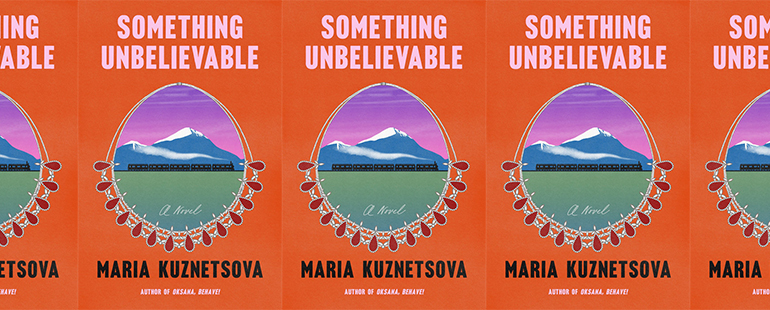The Tradition of Storytelling in Something Unbelievable

Maria Kuznetsova’s second novel, Something Unbelievable, out next week, contains the wonderfully rich twinned stories of a young woman and her Ukrainian grandmother. The woman, Natasha, lives in New York in the contemporary moment and is dealing with a new baby, her struggling career, and her identity as a mother and a wife. Over the course of the novel, as we switch back and forth between the two women’s perspectives, her grandmother, Larissa, who still lives in Ukraine, tells her life story to her granddaughter over Skype. In the process, we begin to understand how tightly the two women are connected, even as the lives they live are vastly different, and how storytelling works to bind generations together.
The nod towards storytelling begins even before the novel starts. The epigraph is a quote from Mikhail Bulgakov, which speaks to the links between generations in its explicit reference to the construction of narrative: “For some a prologue—for others an epilogue.” We are then given a list of characters, including nicknames and relations—“Natalia, called Talia, wife of Fyodor”—and we are also presented with family groupings. These names mean little to us as we begin, although they provide a framework and a reference for the scope of the book. Unlike the classic Russian novels that follow a similar format, however, we don’t really need this here: there aren’t that many characters to keep track of. But simply by including it, Kuznetsova is acknowledging the Russian literature that has come before. Her wonderful sense of humor is included, as well: cats are included as family members and come to play larger-than-life roles in both women’s stories. As we scan the list, we note, too, that Natasha is included in the grouping with her parents and grandparents, while her husband, baby, and cat make up their family group. A foreshadowing, perhaps, of Natasha’s struggle with finding her place in the world. Stas, a friend of her husband, Yuri, doesn’t make an appearance at all in the list of characters, even though he’s a major character in the book. There’s a line being drawn between family and friends.
As the novel begins, we are in Larissa’s point-of-view as she and Natasha talk on Skype, Natasha holding her baby, Tally, in her arms. Natasha asks her to tell the story of how Larissa’s grandmother died during World War II:
I take a moment to collect myself. Why on Earth is she asking now? ‘Of course I can tell you,’ I say. ‘She threw herself under a train. Then the war ended.’
‘Right,’ she says. ‘But I was wondering if you would go a bit more in-depth? You always promised to tell me the whole story, and I thought, Tally would want to learn her history one day—’
‘And soon I will evaporate and you will have no story to remember.’
This exchange—the inciting incident for the novel—sets up the way storytelling will be interrogated throughout the novel. Larissa’s initial impulse is to condense the story of her grandmother’s death into two sentences. This is partially due to her bluntness, her ability to call things as she sees them. But it is also how stories get truncated over time, how the lives of our ancestors are distilled into brief vignettes, and how their lives become braided together with the historical moment. This is not, however, what Natasha wants. Her parents are both gone, and she is somewhat adrift, unsure of what the future holds. So she reaches back in time, claiming that she is asking for her daughter Tally—already, perhaps, understanding that part of her role in her lineage is to be that of storyteller to the next generation—but mostly, she is asking for herself.
Larissa, of course, sees this request as an indication that her granddaughter is expecting her to die sooner rather than later. But rather than saying that Natasha will not have a story to tell, she says that Natasha will not have “a story to remember.” And she is right: stories are held in-store and told to others only upon occasion. As family members die, though, the number of people holding those stories dwindle. It is only through the telling of the stories that they, and the people within them, live on.
Naturally, Larissa is a born storyteller, a woman who knows the power of a good story—“I would often bring novels to our families’ gatherings and would hide off in a corner to escape to my beloved pages”—and she settles into the telling of her family’s story, starting well before the death of her grandmother. And this, too, is the nature of storytelling, particularly stories about family. In order to understand the death of Larissa’s grandmother, it is best to go back further in time, to set the stage, and to understand the scope of the woman’s life, or at least the arc that Larissa is familiar with. As with many family stories, the story is as much about the storyteller as it is about the subject. We, along with Natasha and Tally, settle in for the ride. Of course, the method of storytelling is contemporary—the story is being told over Skype—and yet, presciently, this has become our way of telling stories over the past year, and will be for some time into the future.
Larissa’s story is everything we might imagine a good Ukrainian story to be: fortunes lost, marriages of convenience, travels by train while fleeing Nazis, extreme hunger and cold. Kuznetsova’s humor shines through Larissa’s voice, and she always balances the pathos with the humor, again an echo of many of the Russian masters. Larissa describes her younger sister as follows:
Darling Polya possessed the vapid beauty of a lobotomized swan. Her wild red hair coiffed about her head like the petals of a delicate flower. Her blue eyes, two shining jewels set in the center of her round, startled face, as pale as a porcelain toilet! Her lips, as lush as the banks of the Dneiper in spring. And her figure, as developed and buxom as a sixteen-year-old woman’s by her eleventh birthday. How I loathed her.
There is little sentimentality in Larissa’s telling of her story, her honesty always taking the lead. The freshness of such a voice makes it come alive as it is told. And because we are being told the story in real-time, over Skype, leaning over Natasha’s shoulder, her voice is that much more powerful.
Skype calls can only go on for so long, though, and the novel breaks up the story of the past as it switches to Natasha’s point-of-view in the present. She is a struggling actress, often only called up for clichéd Russian characters like prostitutes and spies. Through this, Kuznetsova questions the prevalence of narrative stereotypes, the ways in which certain characters in stories and films are often one-dimensional and flat. And the actors, as well, are treated similarly, often pigeon-holed into roles based only on their appearance and their name.
Natasha often posts about her career on Instagram, creating another narrative with photos and hashtags. Social media has produced a new way of telling stories. She often notes how her posts about her baby get far more attention than her posts about her career, but if she doesn’t post about herself, she thinks, “no one will remember that I exist.” Rather than telling stories about the past, then, in the contemporary moment, we seem to feel the need to narrate the present in order to be seen. The present is the thing that matters. And yet these stories of today have little longevity beyond the moment, beyond the instant of Instagram.
Despite this contrast, Natasha’s storyline running alongside Larissa’s allows us to begin to see why the two women have such a strong bond: they are cut from the same cloth. They are both strong, honest women, who often use humor to deflect and to understand. Natasha’s world contains struggles that may be familiar to some: the burden of a new baby, an often-absent husband, the appeal of his more present friend. There is an uneasiness in this storyline because the future is unknown, and it is often a relief to return to Larissa and her story of the past which we know will have a beginning, middle, and end. As many have noted during the past year, there is something marvelously transporting in the escape into a good story, one that may carry grief and loss, but one that looks so very different from our own day-to-day reality.
Natasha, in fact, finds Larissa’s story so compelling that she decides to write a play based on it. She ultimately decides that there are too many storylines within the original and so she cuts people out to streamline the play. The list of characters at the start can now be seen in a different light. In a fictive world, characters are expendable. In this plot move, Kuznetsova questions what stories are ours to tell as she examines the impact of the creative narrative decision. But Natasha’s keen interest shows how important the story of her ancestors was to her, and how she also saw the significance in telling the story today: the story of her family’s past gave her a way in which to move forward.
Larissa comes to New York to see her granddaughter’s play, without knowing what it is about, and Kuznetsova nicely ties together the past with the present, allowing both narrative arcs to culminate as one. While Larissa is at first upset about Natasha’s telling of the story (“It is something unbelievable—truly! How could the girl not tell me? How could she hide it from me all summer long—how dare she put my story onstage for strangers to scoff at?”), she comes around to appreciating what her granddaughter has done: “It was fine that she had changed the story, mind you, that she had simplified it, which is something I wish someone had done to my actual life.” The act of storytelling, after all, is the crafting of a narrative, the shaping of real life into art. Larissa has done this as well, by not telling Natasha everything, by keeping some of the information about the past to herself until the very end of the book.
The novel nicely ends in Natasha’s point-of-view, the mantle having been passed from grandmother to granddaughter. By using the first-person voice for both Larissa and Natasha, Kuznetsova provides the reader with the experience of hearing directly from both characters. In this, she uses the vitality of the oral tradition of storytelling, which is how so many family stories are shared. These crafted stories, told by one family member to another, provide a link from one generation to the next, allowing us to connect with the past as we move into the future.
This piece was originally published on April 8, 2021.


